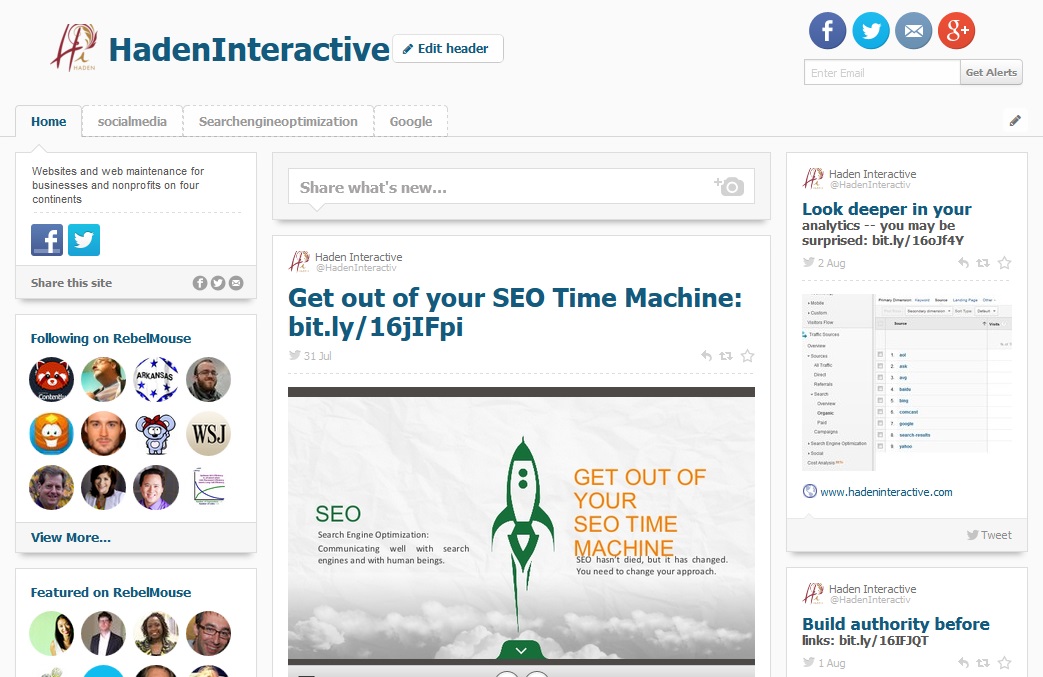RebelMouse is the latest fun social toy, an aggregator which will grab stuff you’ve tweeted, posted on Facebook, or snapped on Instagram and combine it into a nice Pinterest-style board. If you tweet your pins or allow Facebook to show them, you’ll see them on RebelMouse, too. Google + and LinkedIn aren’t in on this one, but most of us will still see most of our social media actions here.
I set up a personal RebelMouse page and one for Haden Interactive, which you can see here, and then I created a page for our lab site, FreshPlans, from its Facebook page on my personal RebelMouse dashboard. You can create RebelMouse pages for any Facebook page you administer (so, if we administer your Facebook page and you want us to do that, give us a shout).
RebelMouse pulls stuff from your Twitter, Facebook, and Instagram accounts and uses its algorithm to determine how to display the items. It shows your Twitter friends who are already on RebelMouse — and in fact it always shows my personal Twitter friends and account, even on the FreshPlans page. That’s a negative. At the moment, it doesn’t appear that you can sign in through your company Twitter account and attach a Facebook page, or create a company account with the company Facebook page and attach your company Twitter account. This also means that if you have multiple pages, the share buttons always tweet and post to your primary Twitter account and personal Facebook page, not to your company page.
However, you can add posts directly to your RebelMouse page. You can add video from YouTube or Vimeo, upload pictures, use links as you do at Facebook or G+, and blog directly. You can use the “Stick It” button to repin things from other RebelMouse pages as you do at Pinterest. Pull it into your toolbar, and you can also stick things from the web.
There are several design options and you can also customize your page. What’s more, you can easily embed your RebelMouse page onto your website. For example, if you have a WordPress site and no blog, you can embed your RebelMouse page into a page on your site and have it function as a blog. You don’t get the SEO benefits of blogging, of course, but presumably you also don’t get the SEO problems of duplicate content which come with reposting things at a blog.

Without the SEO benefits of blogging, this doesn’t seem like a good alternative to a blog, but it could be a good alternative to not having a blog at all, since it could improve the visitor experience and bring people back to your site.
You can see from the dashboard screenshot that embedding is very simple, with several customization options, plus an offer of support if you need it.
Since RebelMouse is an aggregator, you can set up a page and ignore it while you tweet, pin, and post elsewhere. Anyone who visits your RebelMouse page should see your social media activity there even if you never go there yourself. This looks harmless, and you probably should go ahead and do that.
However, RebelMouse may also have some advantages over your other social media options. 
At right you can see my personal Facebook page. Obviously, it’s a personal page and I don’t optimize it. This is just what it looks like when Facebook collects my stuff — a Twitter feed with no pictures, infographics from Pinterest showing as tiny bars, random Likes, ads…
Compare this with what RebelMouse does with roughly the same raw materials (screenshot at the top of the page), and you can see that RebelMouse is a lot more appealing by default than Facebook is.
Of course, you can manipulate both of them, and the final effect will depend largely on your skill at that. Still, with the time constraints we all face and the plethora of social media options, the fact that RebelMouse looks better before you start manipulating it seems like a real plus.
Obviously, the visual effect of RebelMouse is snazzier than Facebook or LinkedIn, and it’s equivalent to Pinterest.
The big drawback to RebelMouse right now is that it’s nowhere near as popular as Facebook. Your customers are much more likely to ask their friends at Facebook or Twitter to recommend a restaurant or a dog groomer than they are to look for one at RebelMouse. However, RebelMouse just started up this summer. If it looks like a good fit for your company, you can be part of driving its growth by inviting your Twitter followers and Facebook pals to sign up.
Should you set up a RebelMouse page for your company, or have your web pros do so? Google+ has reached its first birthday without becoming a major player in social media for most companies, so you might hesitate to jump on another platform just in case it turns out to be the next Pinterest or Facebook. But this appears to be the kind of platform that you can use with little extra time investment — and if it does take off, you’ll be in on the ground floor. We say yes, spend the small amount of time involved in getting your page set up, then watch your analytics and tailor your ongoing involvement to its value for your company.


Leave a Reply